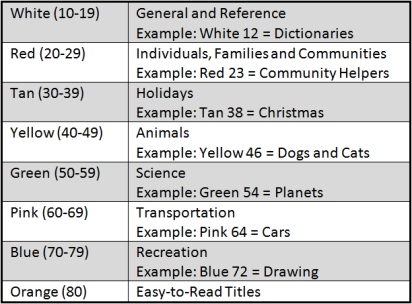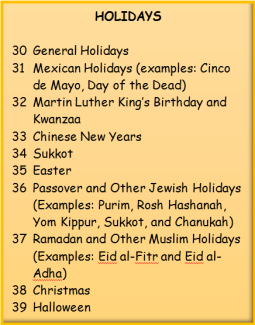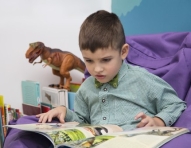By Suzanne Hawley, MLS
 Before joining Brodart I was the librarian at an elementary school in Fairfax County, Virginia. At that time, Fairfax County’s School System had a robust, active library community. We met regularly to share information and best practices with each other, and sometimes hear from guest lecturers.
Before joining Brodart I was the librarian at an elementary school in Fairfax County, Virginia. At that time, Fairfax County’s School System had a robust, active library community. We met regularly to share information and best practices with each other, and sometimes hear from guest lecturers.
During one session, a PhD candidate from one of the local universities told the group about a project she was working on for her doctorate. Specifically, she was trying to develop a unique method for organizing picture books to help children find titles on their own without supervision. The concept included using numbers and colors, both of which are appealing to youngsters. After being introduced to this concept, I began thinking about how I could adapt and implement a similar system in my library.
I knew that revising the categorization for all of our picture books—nonfiction as well as fiction—would be labor intensive and time consuming. I did a lot of begging for help and managed to secure commitments from several volunteers to assist with the effort. We developed a plan and made the change during the summer months when school was out. Staff and parents looked upon the project as a labor of love.
We decided upon a classification system with 10 color-coded categories and 10 numbered sub-sections for each category (with the exception of the Easy-to-Read Titles). Shown below is a rundown of the categories.

On the title page of each book I placed the number of its predominant subject. We purchased small, round, colored labels for each of the eight overall subjects. The correct number for each book was written on the label with a black Sharpie. Then the label was applied to the book’s spine and covered with clear tape. For example, both Martha Rustad’s nonfiction “All about Christmas” and Karma Wilson’s fiction “Bear Stays up for Christmas” had tan labels with the number 38 on them. We also changed the corresponding location of each title on the computer record.

Large, prominently-displayed posters served as directional aides. There was a poster for each of the eight colors with the corresponding numbers and their subjects. The title of each poster was the overall category. For example, “General and Reference” was the title on the white poster. On the side of the poster were the 10 numbers with their matching subjects. Here’s an example of a poster:
The new organizational structure for nonfiction and fiction picture books was an instant hit with students. In fact, it was so successful that I instituted it in two more libraries in Florida schools—again with the help of staff and parents. In all three schools, teachers, kids, and parents frequently mentioned how glad they were to be able to find books so easily.
I’ve been gone from the schools for a while and I’ve often wondered if subsequent librarians reverted back to the traditional classification system: by author’s last name for fiction picture books and Dewey classification for nonfiction picture books.
 Recently, I ran into a couple of primary grade teachers I used to work with and asked if the revised system was still in place. One asked, “You mean the colors and numbers for elementary kids?” When I nodded, she said, “The teachers would mutiny if they changed that system. Makes it so easy for us to do our units. When I do the community helpers unit, I go right to the red section!” I laughed and asked, “Well, how about the kids?” “They love it. Really cuts down on their frustration over finding the right book,” she replied. “Of course, it means that every little boy knows that the dinosaurs are in yellow 41 and spends lots of time there.” That’s what changing the traditional approach was all about!
Recently, I ran into a couple of primary grade teachers I used to work with and asked if the revised system was still in place. One asked, “You mean the colors and numbers for elementary kids?” When I nodded, she said, “The teachers would mutiny if they changed that system. Makes it so easy for us to do our units. When I do the community helpers unit, I go right to the red section!” I laughed and asked, “Well, how about the kids?” “They love it. Really cuts down on their frustration over finding the right book,” she replied. “Of course, it means that every little boy knows that the dinosaurs are in yellow 41 and spends lots of time there.” That’s what changing the traditional approach was all about!
Although I implemented this particular system in a school library, it could easily be adapted for public libraries as well. Do you use an alternative system? If so, I hope you’ll share.
In addition to selecting children and young adult materials for library collections, Suzy Hawley spends her days interfering in her children’s lives as much as possible, wheedling her husband into cooking dinner just one more time, and walking on the beach. Click here for more.

Hi
I am Vidya Dhanwantari. Working with one of the Design Institute of India as a Librarian . I have started color coding system in my Library. I am using DDCclassification system as well as color coding. For example- fashion- pink +391 as per DDC, product design -blue + 658.757 2
Can you help me if any more ideas for library so I can try my best to progress my Library.
LikeLike
Hi Vidya.
Sounds like you are trying to make your library collection as easy as possible for your patrons to find the subjects they’re interested in. Enabling children to search on their own, using colors/symbols/numbers that are easy for them to understand and follow gives them such a sense of independence and accomplishment. I think if you just continue doing what you’re doing, your success will be immeasurable.
Best of luck.
Suzy
LikeLike
Hi Suzanne,
This is a very interesting approach where the color coding is done for subjects and not on age. My question is how can one also classify the book based on age appropriateness? Or will all books on Dinosaur suitable for grade 1 to grade 7 will be in yellow 41?
Thanks
Drishti
LikeLike
Hello Drishti. Thank you for your comment. In answer to the question you posed, I only use the system for picture books, which are intended for grades Pre-K to 2. We consider third grade as the point at which kids begin to read chapter books and more difficult non-fiction titles. Thus, fiction books go into the fiction section, organized by author’s last name, and non-fiction is classified by Dewey number. Sometimes upper-level picture books go into Dewey as well. It’s all predicated on the students’ reading level.
Cheers,
Suzanne
LikeLike
I would love to see a break-down of each color section (the way you showed for the Holiday section). Might you have that?
LikeLike
I love your idea of organizing in this way, but I’m wondering where you would categorize a book like “The Napping House” or “Make Way For Ducklings”. Would those be considered “Easy-to-read titles”?
LikeLike
Hi Kristi.
It was a wonderful tool for elementary school librarians particularly…and almost as much for the teachers as for the primary grade kids. I’d put “Make Way for Ducklings” in the yellow section with duck books and “Napping House” in the red section with families.
I don’t really have the breakdowns anymore but it’s important for each media specialist or librarian to make his/her own breakdowns. Things have changed so much over the years. For example, now there is such a plethora of titles dealing with gender issues, single parent families, parents in prison, and same sex parents. Those should all go into the red section. Also, there weren’t nearly as many easy-to-read titles as there are now. I only put the titles that were labeled in some way”easy-to-read” in the orange 89. But now, you might was to break those up into ER by levels.
My suggestion is to look carefully at your shelves and make your own breakdowns according to what titles you see.
Best,
Suzy
LikeLike